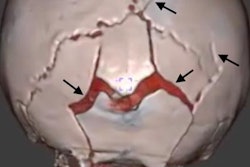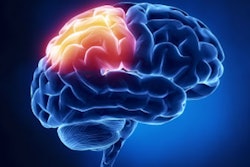
South Korean researchers have developed an MRI sequence that could overcome the modality's weakness in imaging bony structures. They compared its performance to CT for skull imaging in a study presented Sunday at the American Roentgen Ray Society (ARRS) annual meeting in Honolulu.
The approach is known as zero echo time (ZTE) and was created to convert the results from very short T2-weighted relaxation times of regions of interest into high-resolution isotropic images. So far, ZTE skull MRI has provided comparable diagnostic image quality to CT scans for evaluating skull fractures.
"We also believe that ZTE skull MRI may be helpful in managing radiosensitive trauma patients, such as pediatric patients or pregnant women, because it does not generate radiation," wrote lead author Dr. Hye Jin Baek, associate professor of radiology, and colleagues from Gyeongsang National University Changwon Hospital.
The issue at hand is that MRI is not always suitable to evaluate cortical bone structure because of low proton density and short T2-weighted relaxation times of approximately 390 µs at 3 tesla. From a technical standpoint, conventional MRI sequences are incapable of capturing high-quality bone structure images because minimum spin-echo and gradient-echo pulse sequences aren't fast enough to locate a meaningful bone signal, the researchers noted.
Baek and colleagues sought to overcome this obstacle by testing the clinical feasibility of ZTE skull MRI in patients suspected of skull fractures from head trauma. They did so by assessing the diagnostic image quality of ZTE against more commonly used CT images.
The researchers enrolled 13 patients with head trauma who underwent both brain CT and skull MRI scans. Two neuroradiologists compared the diagnostic quality of both image sets on a scale of 1 to 5 and measured skull thickness and the ratio of bone tissue property. Interobserver reliability also was calculated.
The ZTE sequence was able to acquire images from all 13 patients, with skull fractures clearly seen on MRI and well matched with CT results. Both readers independently reported no difficulty in detecting fracture sites on both modalities.
In fact, the mean image quality scores for skull MR and CT showed no statistically significant difference (p = 0.157) in the readers' ratings, as well as substantial agreement between the duo (p < 0.05). The researchers also found no statistically significant difference (p = 0.072) between the modalities in measuring skull thickness, while the mean ratio of the bone tissue property among the three layers of the skull was relatively consistent (p = 0.401), with high interobserver agreement (p < 0.001).
ZTE MRI offers "comparable diagnostic image quality to CT images for evaluating skull fracture with good correlation of quantitative values. Therefore, in some cases, the ZTE skull MRI can be a possible option for clinical use as an alternative to CT image in patients with skull lesions," Baek and colleagues concluded.




















